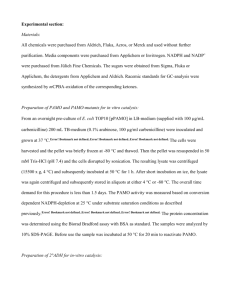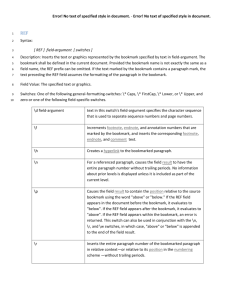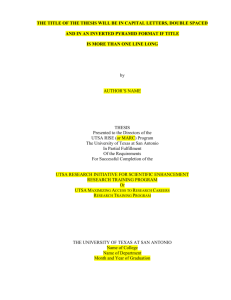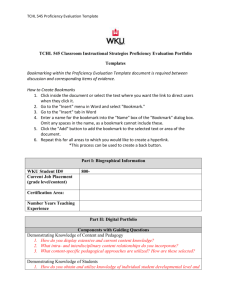Version 1
advertisement
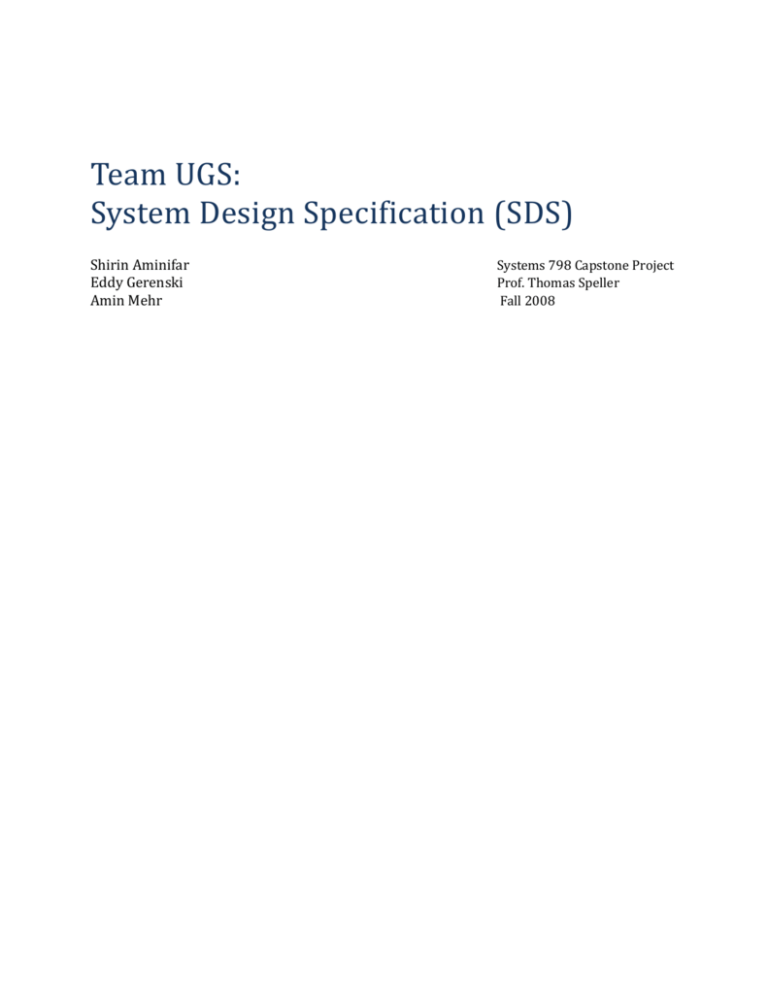
Team UGS: System Design Specification (SDS) Shirin Aminifar Eddy Gerenski Amin Mehr Systems 798 Capstone Project Prof. Thomas Speller Fall 2008 Team UGS SYST 798 Fall 2008 SRD 17 OCT 2008 Table of Contents 1.0 Introduction ...................................................................................................................................... 3 1.1 Purpose .......................................................................................... Error! Bookmark not defined. 1.2 Business Context ............................................................................ Error! Bookmark not defined. 1.3 Scope/Problem Statement............................................................. Error! Bookmark not defined. 2.0 General System Description .............................................................................................................. 3 2.1 System Context .............................................................................. Error! Bookmark not defined. 2.2 System Modes and States .............................................................. Error! Bookmark not defined. 2.3 Major System Capabilities.............................................................. Error! Bookmark not defined. 2.4 Major System Constraints .............................................................. Error! Bookmark not defined. 2.5 Operational Scenarios .................................................................... Error! Bookmark not defined. 3.0 System Requirements ........................................................................ Error! Bookmark not defined. 3.1 Business Requirements .................................................................. Error! Bookmark not defined. 3.1.1 Cost Requirements ................................................................. Error! Bookmark not defined. 3.1.2 Market Requirements ............................................................ Error! Bookmark not defined. 3.1.3 Supplier/COTS Requirements ................................................ Error! Bookmark not defined. 3.2 Functional Requirements ............................................................... Error! Bookmark not defined. 3.2.1 Detect Physical Intrusion/Presence ....................................... Error! Bookmark not defined. 3.2.2 Locate Intrusion ..................................................................... Error! Bookmark not defined. 3.2.3 Notify of Intrusion .................................................................. Error! Bookmark not defined. 3.3 Non-Functional Requirements ....................................................... Error! Bookmark not defined. 3.3.1 Performance Requirements ................................................... Error! Bookmark not defined. 3.3.2 Physical Construction ............................................................. Error! Bookmark not defined. 3.3.3 Durability ................................................................................ Error! Bookmark not defined. 3.3.4 Environmental Conditions...................................................... Error! Bookmark not defined. 3.3.5 Operational Requirements..................................................... Error! Bookmark not defined. 3.3.6 Safety Requirements .............................................................. Error! Bookmark not defined. 3.3.7 Reliability Requirements ........................................................ Error! Bookmark not defined. 3.3.8 Other Requirements .............................................................. Error! Bookmark not defined. 3.4 Interface Requirements ................................................................. Error! Bookmark not defined. 3.4.1 Hardware Interfaces .............................................................. Error! Bookmark not defined. 1 Team UGS SYST 798 Fall 2008 SRD 17 OCT 2008 3.4.2 Software Interfaces ................................................................ Error! Bookmark not defined. 3.4.3 Communications Interfaces ................................................... Error! Bookmark not defined. 3.4.4 External System Interfaces..................................................... Error! Bookmark not defined. 3.5 Information Management Requirements ...................................... Error! Bookmark not defined. 3.6 Policy and Regulation Requirements ............................................. Error! Bookmark not defined. 3.7 Lifecycle and Sustainment Requirements ...................................... Error! Bookmark not defined. 4.0 3.7.1 Supportability ......................................................................... Error! Bookmark not defined. 3.7.2 Maintainability ....................................................................... Error! Bookmark not defined. Appendix ............................................................................................ Error! Bookmark not defined. 2 Team UGS SYST 798 Fall 2008 1.0 Introduction 1.1 Scope SRD 17 OCT 2008 The intent of this System Design Specification Document (SDS) is to encapsulate the hardware and software that is will be chosen for MINUS system based on stakeholder analysis, the system Concept of Operations (CONOPS), preliminary conceptual/functional designs, and most importantly the System Requirments Document (SRD). The SDS will define the form architecture spelled out in the SRD and defined in the CONOPS for a future unattended ground system. The hardware specifications here outline the MINUS system will later be mapped to a traceability matrix for proof of one-to-one matching. 1.2 System Description The System Design Specification will break down the components included in MINUS based on the hardware/software chosen for the final design. Each element of the inclusive system will spell out the physical characteristics of the components that were selected. Items such as weight, size, and functionality will be described in detail in order to fully understand the relationship between what components were chosen and how it relates to the system. Furthermore, this document includes additional hardware packages that could be included by future buyers as seen in the business case. 2.0 General System Specification – Sensor Node 2.1 Crossbow IRIS Mote 2.1.1 2.25” x 1.25” x 0.25” Wireless measurement system 2.1.2 Built in acoustic, vibration (seismic), and temperature sensors capable of sensing up to 20 meters. 2.1.3 The IRIS Mote is capable of sending and receiving messages of up to 128 bytes in length. 2.1.4 Powered via a DC-DC booster, which maintains a constant 3.3 volt input regardless of battery voltage and draws 8mA when sending/receiving data. 2.1.5 Draws a total of 8 micro-amps when in sleep mode. Sleep mode can be programmed 2.1.6 Expansion connector for light, thermal, RH, barometric pressure, acceleration/seismic, acoustic, magnetic and other Crossbow sensor boards 2.1.7 Plug and play with Crossbow’s sensor boards, data acquisition boards, gateways, and software (USB, serial). 2.1.8 Direct sequence spread spectrum radio which is resistant to RF interference and provides inherent data security. 2.1.9 IEEE 802.15.4 compliant RF transceiver 2.1.10 2.4 to 2.48 GHz, globally compatible ISM band. 2.1.11 Outdoor line-of-sight tests yield ranges as far as 500 meters between nodes without amplification. 2.1.12 Large Scale Sensor Networks of over 1000 nodes 3 Team UGS SYST 798 Fall 2008 SRD 17 OCT 2008 2.1.13 Wireless Communications with every node as router capability 2.1.14 Weight 0.7 ounces (18 grams) 2.1.15 Temperature Range: -40 ~ +85 degrees C 2.2 Processor 2.2.1 The IRIS Mote processor is based on the Atmel ATmega1281. 2.2.2 The ATmega1281 is a low-power microcontroller which runs from its internal flash memory. Runs on a 3.3 battery voltage 2.2.3 The processor board can be configured to run sensor application/processing and the network/radio communications stack simultaneously. 2.2.4 The IRIS 51-pin expansion connector supports Analog Inputs, Digital I/O, I2C, SPI and UART interfaces. These interfaces make it easy to connect to a wide variety of external peripherals. 2.2.5 A base station allows the aggregation of sensor network data onto a PC or other computer platform. Any IRIS Mote can function as a base station when it is connected to a standard PC interface or gateway board. 2.2.6 Able to transfer detection from multiple sensors and process data to within 1 second 2.2.7 Error rate (false alert/detection) of .5% of for triggered detections 2.3 IRIS Zigbee RF Module Communications 2.3.1 Module consists of RF Transceiver, RF circuitry and 8051-compatible MCU and external components, integrating ZigBee certified stack software and 802.15.4 MAC protocol 2.3.2 Silicon based protocol operating on the IEEE 802.15.4 Standard for physical layer and medium access control and reliable wireless communication 2.3.3 Networks can contain 65536 nodes 2.3.4 Supports 128-bit encryption 2.3.5 Data sending: Between 210 and 240 kbits/s 2.3.6 Power: typical average is 20 and 35 mAmp 2.3.7 Operating Temperature Range: -40 ~ +85 degrees C 2.3.8 Suitable for high volume data streaming applications that allow for large networks such as sensing and control 2.3.9 Encrypted IP addresses issued to each individual node 2.3.10 Open source language for use on any platform or GUI 2.4 RF Zigbee Antenna 2.4.1 The length of the λ/2-dipole antenna is given by: L = 14250 / f where f is in MHz, giving the length in cm. An antenna for 2450 MHz should be 12 cm. 2.4.2 Receiver Sensitivity: -92 dBm / -100 dBm 2.4.3 Operating Frequency: 2.4 GHz / 2.4 GHz 2.4.4 Outdoor Line-of-sight Range: 300’ (100 m) / 1 mile (1.6 km) 4 Team UGS SYST 798 Fall 2008 SRD 17 OCT 2008 2.4.5 RF Data Rate: 250000 bps / 250000 bps 2.4.6 Operating Current and voltage: 3.3 volts 2.4.7 Operational temperature range of -40 ~ +85 degrees C 2.5 Crossbow MTS420 Sensor Board w/ GPS Module 2.5.1 The Crossbow MTS420 Sensor Board w/ GPS module is capable of acquiring standard GPS information and forwarding that data through its 51 pin connector to the IRIS mote in ASCII format. 2.5.2 The functionality of the GPS module by tracking a moving object’s location using longitude and latitude coordinates. 2.5.3 Powered via a DC-DC booster, which maintains a constant 3.3 volt input regardless of battery voltage and draws 60mA when sending/receiving data. 2.5.4 The output from the GPS module is connected to a serial uart, USART1, interface of the IRIS mote. An active, external, antenna is supplied with the module. 2.5.5 The GPS module supplies the antenna power for the GPS 2.5.6 Power for all of the sensors on the MTS420 sensor board is controlled through an analog power switch. It can be programmed enable and disable power to individual sensors. It can also be programmed to have a sleep mode. 2.5.7 The MTS420 GPS sensor is accurate to within 10 meters. 2.5.8 Operational temperature range of -40 ~ +85 degrees C 2.5.9 The mote that is programmed will be used to collect GPS data. The data is assembled as encrypted data packets and be transmitted to the base station using the RF link. 2.5.10 The IRIS mote that is linked to the MTS420 GPS is able to store data 2.5.11 Acquisition times for the MTS420 GPS are typically .1 seconds. GPS Chipset Antenna Channels Meters Reacquisition Time Protocal Current Interface 2.6 SiRFstarlleLP Active antenna, power supplied by GPS module 12 10m .1 sec (typical, w/o dense foliage NEMA-0183 60mA at 3.3 V Serial Interface On Board Sensors (Acoustic) 2.6.1 IEEE 802.15.4/Zigbee compliant 2.6.2 Additional acoustic channel allowing high frequency sampling of voice and other noise signals 2.6.3 detects in a full 360º coverage pattern 2.6.4 12 meter detection range of 10-100dB 5 Team UGS SYST 798 Fall 2008 SRD 17 OCT 2008 2.6.5 Programmable logic chip to set to certain decibel ranges (10-100db) 2.6.6 Operational temperature range of -40 ~ +85 degrees C 2.6.7 Operational voltage: 3.3V 2.7 Custom Sensors 2.8 PIR Sensor (optional) 2.8.1 2.8.2 2.8.3 2.8.4 2.8.5 2.8.6 Long-range passive infrared (PIR) sensor 90-100° wide detection cone 20-30 feet detection range for human presence 50-100 feet detection range for vehicles Adjustable time constant in PIR sensor output for customized applications TinyOS and Java code support available for sampling sensor channels, display readings on a PC 2.8.7 Power saving sleep mode 2.8.8 Operational range of -40 ~ +85 degrees C 2.8.9 100microAmp draw when detecting 2.8.10 2.9 2.9.1 2.9.2 2.9.3 2.9.4 2.9.5 Honeywell HMC1002 Magnetometer Field range up to -2 to +2 gauss (±6 gauss) Operating temperature -55 to 150 degrees C Weight .53 grams Current draw on 3.3 Volts = 7mA Distance of up to 25 meters 2.10 Power System 3.0 Panasonic HHR150AA All Purpose Battery 3.0.1 The Panasonic HHR150AA 3V all purpose battery offers 10000mA-hours capable of delivering power to all components of the UGS for approximately 28.95 days at when at 70% sleep mode operation. 3.0.2 Has the capacity to recharge and recharges at a rate of (I need to do calc) and can be charged and discharged for more than 500 cycles. 3.0.3 The battery can be charged/discharged at temperature ranging from -10degrees Celsius to 60degrees Celsius. 6 Team UGS SYST 798 Fall 2008 SRD 17 OCT 2008 3.0.4 Complies with the OSHA Communication Standard on the identity of hazardous chemicals, health, and physical hazards 3.1 Futurelec 0.5V 280mA Solar CellSolar Module (optional) 3.1.1 3.1.2 3.1.3 3.1.4 3.1.5 3.1.6 3.1.7 3.1.8 3.1.9 3.2 Dimensions: 60mm x 30mm x 2.8mm (LxWxD) Peak Voltage (Vmp): 0.48V Maximum peak power 19 Watt Rugged reinforced thin cell (RTC) design Thermal Cycle 1600 Cycles Operating temperature range: -40°C …. + 85°C, waterproof encasing Transparent insertion into existing systems anti-reflective coating (ARC) efficiency of typically 17%, Futurlec solar cells give the ability to extend run time in "low light" Custom Enclosure 3.2.1 Custom made injection molded plastic polymer encasing non-relective and/or glossy finish 3.2.2 24inch x 24inch x 12inch dimension 3.2.3 Color: Earthtone brown or variable depending on setting 3.2.4 Weight: <1kg 3.2.5 Water tight enclosures up to 10 meters 3.2.6 Air tight enclosures 3.2.7 See AutoCAD drawings 3.2.8 Nitrogen purged enclosure 3.2.9 MIL Standards that apply are: MIL-STD-IP6 (dust free) 3.2.10 MIL-STD-810F -516.5 (Shock) - 520.2 Temperature, Humidity, Vibration, and Altitude - 509.4 Salt Fog - 510.4 Sand and Dust - 507.4 Humidity - 506.4 Rain - 522 Ballistic Shock 7 Team UGS SYST 798 Fall 2008 SRD 17 OCT 2008 3.3 Seismic Sensor 3.3.1 3.3.2 3.3.3 3.3.4 3.3.5 3.3.6 Sensitivity: 100mV/g (nominal @ 80Hz). Operating Temperature: –25...140°C. Frequency Response: 1Hz...10kHz (3dB points) Supply Voltage: 3.3V Supply Current: 0.5mA...8mA. Distance of up to 25 meters AutoCAD file referred from 3.2.7 3.4 Supportability 3.4.1 Mean-time repair of 3 days 3.4.2 Repair of COTS items are at discretion of individual warranties. 8 Team UGS SYST 798 Fall 2008 SRD 17 OCT 2008 9



